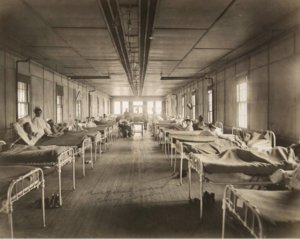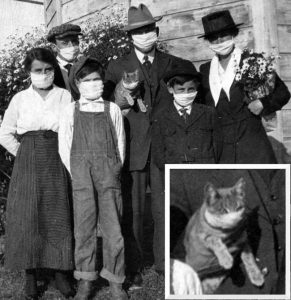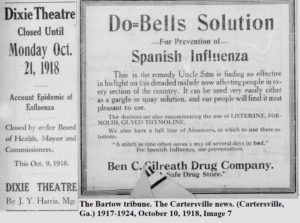By Joe Head
April 12, 2020

Never in a hundred years! How often have you heard or uttered that phrase meaning you will not see such an event in your lifetime? Well, it is now the 100 years!
Twenty years into the 21st century an international pandemic has produced an historic crises for the nation and world with a novel virus known as COVID-19. As a result Bartow finds itself once again in the grip of a national and international epidemic that relies on physical distancing, clean hands, covered noses and mouths to mitigate a virus 100 years later.
Take a look back, just 102 years ago. In 1918, Bartow County suffered, along with the nation, its worst pandemic on record, the Spanish Influenza or La Grippe! World War I was raging and the world was sick.
According to the October 18, 1918 Annual Report of the Georgia State Board of Health, a sobering report was presented on the status of the epidemic in Georgia, specifically citing Cartersville. It included a mention of new cases within the previous 24 hours. Statewide there had been 2,749 new cases, with 48 deaths in one day. Hardest hit was Cartersville, with almost 1,000 new cases the previous day occurring on October 17, 1918, according to the data published. Cartersville’s population at that time was approximately 4,200.

It is not precisely known how the pandemic originated, but in Georgia it appears to have begun at Camp Gordon (12 miles outside of Atlanta) among the WWI recruits, as it did in many other states. As soldiers were transferred from base to base readying for the Great War, infections broke out on most military bases. Eventually the base was quarantined, but not before the plague crept into the Georgia population. (Several Bartow boys died from the flu at Camp Gordon.) The global origin of the Spanish flu is uncertain, but was likely coined as a result of the massive devastation it caused in Spain during 1918. It appears the novel COVID 19 virus first surfaced in Wuhan China in late 2019 and spread across the continents.
Atlanta Mayor Asa Candler (former Cartersville resident) took steps to close schools, churches, theaters and other venues that attracted large crowds. He banned soldiers from the city, but stopped short of closing businesses. La Grippe, an outdated term for a highly contagious flu, introduced the need for physical distancing between individuals as a mitigation step to manage the spread of the virus. The University of Georgia suspended classes.
On the home front, Dr. Howard Felton, (Cartersville’s version of doctors Fauci and Birx) head of the Cartersville Board of Health advised of precautionary measures that should be taken by the city. He asks for the schools, theaters and churches to be closed. Among the first to respond were Sam Jones Methodist, First Presbyterian, Felton’s Chapel and First Baptist churches. He followed up with a letter to the Mayor indicating that the virus affects the weak, rundown and all ages. Speculation is that it leads to pneumonia and death.
Following the report that Cartersville experienced 1,000 cases in one day, Dr. Felton refuted the information in an October 20 article posted in the Atlanta Constitution. According to Felton, the city has 150 cases and the county has about 800 cases. He adds the situation is serious in Cartersville and four of the five doctors are ill with the disease. (The original report may have combined the city and county numbers -950- to estimate the 1,000 cases.)
By late October 1918 more than 250 cases of the flu had been reported in Cartersville.

On October 24, Dr. Felton, took more dramatic action to slow the virus. He recommended to the mayor an extension of the ban indefinitely. He insisted on a ban to stop the promiscuous spitting of tobacco products and phlegm on the sidewalks to be enforced with fines ranging from $10.00 to $200. He ordered signage to be posted warning of fines and good conduct to prevent infections.
Local physicians were working night and day to treat the ill. The first cases were reported in the county among large families. Dr. Felton mentions that large rural families were more likely to spread the virus quickly. As the situation worsens, Dr. Felton begins a series of newspaper articles to instruct on how to avoid the virus and home care for the sick.
His advice includes: avoid large groups, keep hands out of mouth, cover mouth/nose when coughing or sneezing, keep feet dry, stay out of drafts, wash hands frequently, de-clutter the sick room, use no rugs, stay in a well – ventilated room, cool compresses or even sleep in a screened-in room for fresh air and use individual wash basins and towels. He further advises a soft, but nutritious diet that may include: milk, soft boiled eggs, toast, stewed fruits, oatmeal and hominy.
Also, he recommends feeding the sick from separate dishes if possible. If a fever or pinkish phlegm or sputum should appear, call a doctor. He clearly advises caretakers to wear a mask made from gauze as the virus is airborne. He even provides sewing instructions and follows with instructions to boil masks for reuse. He instructs how to use a thermometer and encourages the use of wearing an apron or gown when caring for the sick. Another article advises how to avoid catching the flu followed by tips of what to do if you do contract the flu.
The situation in Cartersville continues to decline in the fall of 1918. As a result Dr. R. E. Wilson attends a Chicago Conference to learn more about the flu and how to combat it. He learns that from September 18 to December 1, some 350,000 US civilian deaths are expected. Among other precautions, the conference encourages the use of gauze masks.
An article from the Los Angeles Evening Herald is printed citing experts disagree about the use of masks and ask for such practices to be deferred. Their argument centers around the efficiency of face coverings.
Atlanta newspapers feature Dr. William Brady’s “Health Talk” column and a call to centralize case reporting for tracking purposes. The flu was characterized as tricky and also known as la grippe. Another Health Talk by Dr. Brady featured information that any person resembling having a cold should keep a minimum of five feet away as coughing, sneezing or laughing sprays the surrounding area with droplets. The Atlanta Journal printed a call for women to sew 100,000 masks to meet the need.

Some preachers published articles that the epidemic is a curse of God. The tabloids carried ads for elixirs, tonics and certain whiskeys that were touted to remedy the illness. Likewise, recipes for poultices to be applied to the throat, chest and feet were lauded as treatments. Concoctions of boiled onions, apple vinegar thickened with rye meal and other brews often were tried to overcome the suffering.
Dr. A. B. Greene is quoted in the paper urging people to place oily preparations in their nasal passages. It is his opinion that germs have a difficult time living in such substances.
In late November, the Cartersville council asks several doctors to inspect the local schools to determine if they can be reopened. Local doctors agreed to conduct rotations among the schools. Students were asked to report and inspections were made over a week. The East Side School attendance was 50% and the West Side School was 90%. The doctors concurred it would be permissible to allow schools to resume, but any student showing symptoms would be sent home immediately. However, by January 16, 1919 the schools had to be closed again. Soon the virus began to break out in the convict labor camps first appearing at the Hall Station camp. Medical professionals were advocating for the public to be “inoculated”. A popular event was the county fair and many advocated for it to not be canceled.
The resurgence saw a presence of the Red Cross to begin teaching home health care and trying to mitigate sickness in large families. They, too, were advocating for entire families to get inoculated. Even as late as February of 1920, local schools were advised to not allow students to gather in groups or around the warming stoves, no dry sweeping of the floors, or spray floors before sweeping, try to keep room temperatures cool and to immediately report children with sniffles and colds.
A conference was held in Macon on February 2, 1919 to discuss the influenza. The presentation included data of estimated cases to date and that the epidemic will cost the state over 45 million dollars.
In a local book entitled, The Country Doctor’s Wife written by Ora Lewis Bradley a chapter is dedicated to the many Dreaded Diseases suffered in Bartow County. She mentions diphtheria, typhoid, tuberculosis (consumption), la grippe and pneumonia all of which took a human toll on early Bartow county. Additionally, the newspapers of 1870 to 1920 carried stories of small pox, sick farms and rumors of other illness that often were not true and were retracted.
By late 1919 the Spanish Flu had run its course. On January 15, 1919, The Atlanta Constitution reported that 30,768 Georgians died of influenza to that date. The nation suffered 675,000 deaths and the world lost 50 million souls. It appears early record keeping regarding cases and mortality in Bartow County were not available in sources found for this research.
Even today some native Bartow residents recall their grandparents speaking of the Spanish flu. Shirley Perry of Cartersville recalls her dad, Thomas Bradley Hendricks, who grew up in the Dewey community of northeast Bartow County sharing a story. He was five during the flu and often shared the stories of his parents about how the family suffered during the epidemic. His parents often related how hard the families around them were hit in the Gum Springs and Folsom area. He shared that entire family units were wiped out with the flu and many were buried in the Hayes and Hendricks cemeteries.
EVHS member Sam Graham also recalls stories from his grandfather who contracted the flu. He was one of eight children reared on a farm. While in the army he was confined to a leaky tent with rain water constantly dripping on his bed. He did survive the flu.
Janet Neel, near White shares a letter that her grandmother (Oviedo, Florida) wrote to her grandfather who was stationed in Ireland during WWI. She updates him on the Spanish flu indicating the family is still safe, but the schools and churches have been closed by order of the government. She mentions that the doctor has inoculated many, but the government stopped inoculations as they needed the serum for the army. Her other grandfather (Clonts) living in Bethel near Hiram also spoke of seeing friends one Sunday at church and they were dead the next Sunday.
Upon this quick reflection, it is clear Bartow is not new to the scourge of a viral epidemic. Research clearly shows Bartow history has grappled with isolation and social distancing well before it became again fashionable in 2020. Perhaps century old advice and stories still have lessons of value in today’s modern world.
_____________________
Appendix
A summary of suggested mitigation actions 100 years ago vs today’s COVID -19
| Mitigation Suggestions | 1918 | 2020 |
| Cover nose and mouth when coughing/sneezing/laughing | Yes | Yes |
| Keep physical distance of 5 – 6 feet | Yes | Yes |
| Wash Hands often | Yes | Yes (20 seconds) |
| Wear Masks | Yes | Yes |
| Sleep/Rest in well ventilated room | Yes | No |
| Post hygiene signs of directions to follow | Yes | Yes (digitally mostly)/ Television/Newspapers |
| Close venues with crowds: theaters, churches, schools, etc. | Yes | Yes |
| Keep feet dry | Yes | No |
| Recommended home-made masks with directions provided | Yes (news articles) | Yes (digitally) |
| Refrain from promiscuous spitting of tobacco products and phlegm | Yes | No |
| De-clutter sick room | Yes | No |
| Face covering controversy | Yes | Yes |
1918 Spanish Flu Tips About Social Distancing
Tips drawn from a variety of national newspapers
1. Stop Kissing and keep five feet of distance between persons
2. Avoid using public pay phones
3. Funeral gatherings banned
4. Schools, Salons, Theaters, Saloons and Churches closed
5. City Wide Mask Ordinances to be implemented
6. Quarantine Regulations printed in local papers and posted in public spaces
7. All Influenza cases must be reported
8. Stop spitting on public sidewalks
9. Gatherings only permitted in open air spaces
10. Breathing remedies and rubs advised (Liniments, Gargles, Vapor Rubs, Nostriola, Atomizers)
11. Keep warm, dry, out of drafty areas and eat a healthy diet with plenty of water
12. Avoid stress, worry and anxious situations
13. Walk or bike to work, avoid trains and buses
14. Avoid common drinking cups and hand towels
15. Cover your mouth and nose when coughing or sneezing
16. Wash hands frequently
17. Clean door knobs and typewriter keys often
18. Post notices on your front door if influenza has infected a family member
19. Keep clothes clean, declutter your home, remove trash often and wash food well
20. Get Inoculated, it causes no harm
To read a companion article about Cartersville’s COVID 19 Chronicles visit: https://evhsonline.org/archives/48827
Bibliography
Note: Some article titles have been paraphrased or abbreviated
Health Talks, Atlanta Constitution, February 2, 1918
Flu Treatments, Atlanta Constitution, February 23, 1918
Half of Gordon Banned to City of Atlanta, Atlanta Constitution, September 21, 1918
University of Georgia Closes, Atlanta Constitution, October 19, 1918
Defer Action to Wear Masks, Los Angeles Evening Herald, November 7, 1918
100 Thousand Masks Needed, Atlanta Constitution, October 4, 1918
Precautionary Measures, Tribune News, October 10, 1918
Flu Ban Extended Indefinitely, Tribune News, October 17, 1918
Cartersville Flu Report Exaggerated, Atlanta Constitution, October 20, 1918
Dr. Felton Extends Ban, Tribune News, October 24, 1918
Church Ban Relaxed, Bartow Tribune News, October 31, 1918
Home Care is Needed in all Influenza , Tribune News, October 31, 1918
Home Care is Needed in all Influenza, Bartow Tribune, November 7, 1918.
Dr. Wilson Attends Chicago Conference, Tribune News, November 12, 1918
Schools Resume, Tribune News, November 21, 1918
30,768 Georgians Die, Atlanta Constitution, January 15, 1919
Schools Close Again, Tribune News, January 16, 1919
Health Talks, Atlanta Constitution, Atlanta Constitution, January 1, 1919
Epidemic of Flu to Cost State 45 Million, Atlanta Constitution, February 1, 1919
School Instructions, Tribune News, February 10, 1919
Flu Conference Held, Atlanta Constitution, February 2, 1919
6018 Flu Cases in State, Atlanta Journal, March 27, 1919
Ban Lifted, Tribune News, February 26, 1920
Books, Reports, Internet, Societies
Annual Report of the Georgia State Board of Health, 1918
The Country Doctor’s Wife, Ora Lewis Bradley, 2014
Influenza Encyclopedia, University of Michigan
htmlwww.historyofvaccines.org/content/blog/spanish-influenza-pandemic-and-vaccines
Bartow Genealogical Society
Acknowledgements:
Debbie Head for her editorial contributions
Sam Graham for his research assistance
Margaret Mathison, RN for her advice
Anna Maria Floyd, Bartow County Health Department
